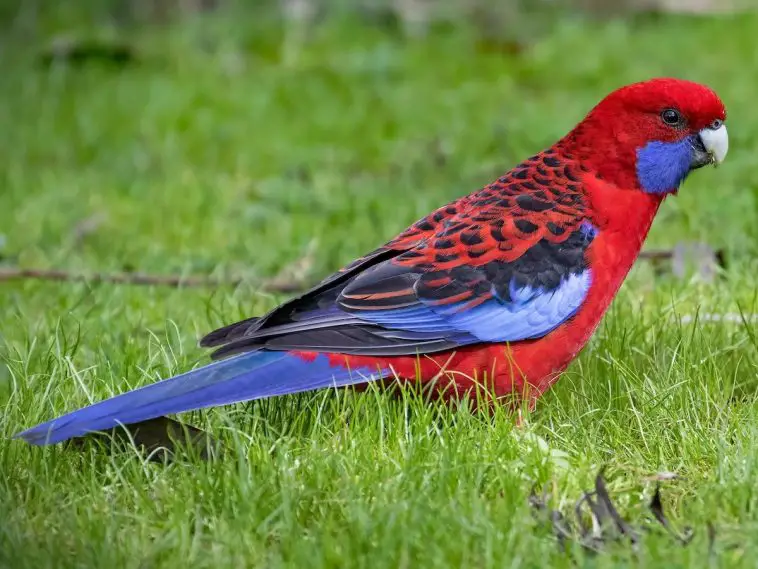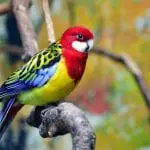Scientific Facts
| Crimson Name | Crimson Rosella |
| Scientific Name | Platycercus elegans |
| Life Span | 15+ years |
| Size | 26 to 37 cm long |
| Habitat | Forests, woodlands, suburban parks, farmlands, and gardens |
| Country of Origin | Australia |
Physical Description
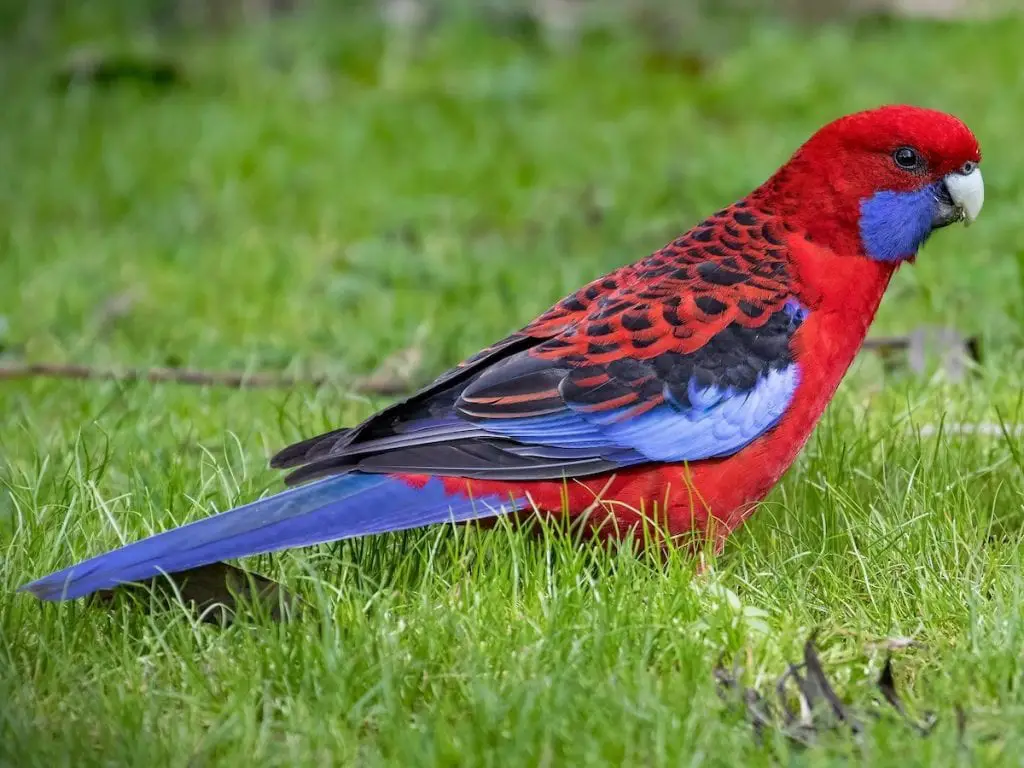
The crimson rosella is a colorful parrot that is found in the eastern and southeastern parts of Australia. This species has been introduced in New Zealand and Norfolk Island and is found in areas like forests and gardens.
The crimson rosella encompasses two previously separated species that are the yellow rosella and the Adelaide rosella. The red-colored species of rosella has some alternate names like Pennant’s parakeet, Red Lowry, Campbell parakeet, mountain lowry, mountain parrot, or simply lowry.
Meanwhile, the yellow rosella is also known under a variety of names, including Murray rosella, swamp lowry, Murrumbidgee lowry, and the yellow-rumped parakeet.
The crimson rosella is a medium-sized parrot native to Australia. It can grow up to 14 inches long, and most of this length is its lovely tail. In the seven subspecies of the rosella, four of these are crimson. The red will be replaced by yellow plumage for variety. Usually, a combination of red, yellow, and orange are in the Adelaide rosella subspecies.
The adult and juvenile crimson rosella have very dramatic color combinations found in south-eastern rosella populations. These parrots have predominantly green-olive body feathers in young parrots with more persistent coloration along its breast and nape.
Young parrots will develop a brighter color as they grow older. The green color will eventually turn bright red like a tomato. All rosella races have blue cheeks with black scalloped and blue-margined wings with blue tail with red marks. Meanwhile, this bird’s tail feathers are the most favorite nest décor of the bowerbird. Finally, it has a pale gray bill while the irises are dark brown.
There is very little difference between the male and female crimson rosellas. The most noticeable difference is the size. Males are larger than females, which 15% larger. Males are larger and have a wider and larger beak.
Subspecies
The crimson rosella has the following subspecies:
- P. elegans is the nominate race of eastern New South Wales and Victoria
- P. elegans nigrescens a subspecies found in the northeastern coasts of Queensland. This is the smallest subspecies.
- P. elegans melanoptera, a subspecies located in Kangaroo Island. This is the largest subspecies. Both the melanoptera and the nigrenscens are darker compared to the nominate race.
The young birds of the nigrenscens do not have the greenish-juvenile plumage that is present in other subspecies of the crimson rosella.
Meanwhile, the yellow rosella is native to the areas near the Murray River and several of the river’s tributaries. This species was reclassified as a subspecies of the P. elegans flaveolus because the two interbreed in the places where their ranges overlapped. However, the crimson areas are replaced by light yellow while the tail is green.
The Adelaide rosella is from Adelaide and in the surrounding areas. This was thought to be a separate species, but it could be a hybrid specimen which began by breeding the yellow and crimson rosella. The two species interbreeds with the Adelaide rosella in the area where their ranges cross, and the result exhibits a variation in the feather colors from dark orange-red in species found in the south to pale orange and yellow for species in the north. Plumage colors that are very close to the yellow species are known as subadelaide.
Crimson Rosella status
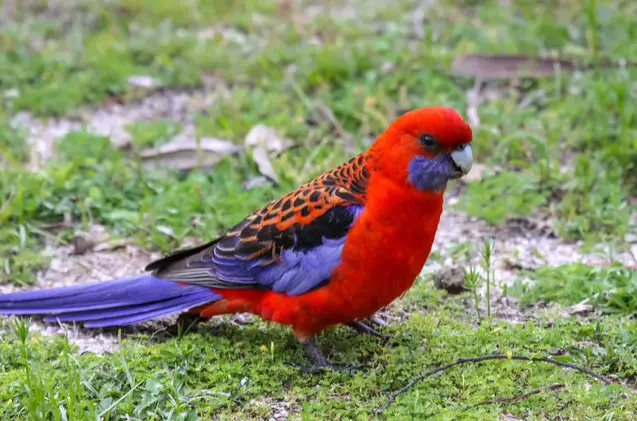
The crimson rosella is very abundant all year round and is considered as species of least concern by the IUCN. But despite being abundant in their native areas, experts believe that it won’t be long when the population of the crimson rosella greatly diminishes because of environmental changes and illegal pet trade.
With these in mind, you may consider adopting a pet parrot rather than buy from a trader or a local supplier. You’ll be stopping illegal pet trade and preserving the population of birds like the crimson rosella as well.
Lifespan
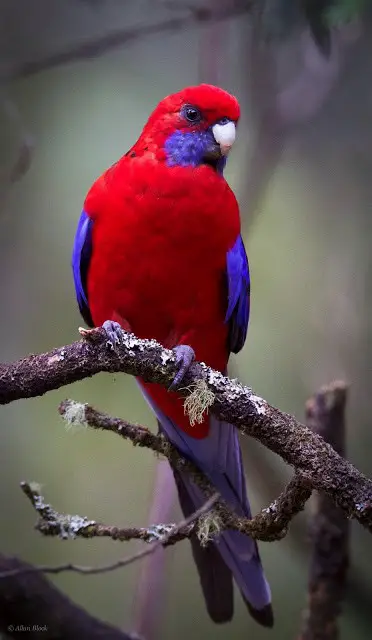
The crimson rosella is one of the hardiest birds. They can move from place to place to search for good and bountiful food and a safe place to nest in. And because of these, they can live almost 10 years in the wild.
In captivity, the crimson rosella can live for more than 15 years. This is because of caring for pet owners who provide healthy food, proper care, companionship, and a safe place where the birds can stay. These birds are also safe from predators when in captivity, which further extends their lifespan.
Natural Habitat

Crimson rosellas are found in coastal and mountainous forests. These live in woodlands and forests with wet and old trees. This is possibly due to more insects living in wetter areas, and old trees are perfect nesting sites.
These colorful birds are found in tropical forests and subtropical to temperate rainforests. These are also present in wet and dry sclerophyllous forests, woodlands, and riparian forests to the sea level and up the tree line.
Flocks of crimson rosellas can also live in areas where humans are located like pastures, parks, farmlands, reserves, golf courses, and gardens. These birds will live anywhere as long as there are trees. They use the highest branches for roosting and for steering clear from predators.
Predators
Crimson rosellas have several known predators like large birds of prey, including the grey goshawk, owl, and peregrine falcon. It is prey to feral cats, possums, and foxes. Currawongs will take the crimson rosella’s eggs from their nests and eat them.
Perception and Communication

If your heart is set on caring for a talking bird, then you might as well look elsewhere. Although the crimson rosella is a lovely and intelligent bird, it cannot mimic human words. The most they can do is to mimic whistles and tunes. You can whistle songs and short tunes, and this bird can easily follow through.
The crimson rosella also has a very loud call that will irritate you from time to time. This sound can turn into a high-pitched shrill, which means that the bird is alarmed.
Behavior
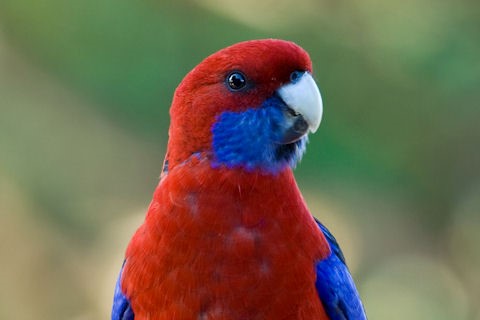
Before you decide on getting a crimson rosella, consider the following natural behaviors:
Can perch on your shoulder
The crimson rosella can be trained to perch on your arm or shoulder. They are smart and will stay composed as you walk. But to do this trick, you must constantly train it and interact with it so it will trust you completely.
May not like petting
It is common for a crimson rosella to resist being petted, and this is true even for a well-trained bird. It can be well-behaved but will still resist cuddles and pats more so kisses on the head. It may nip on you if you attempt to snuggle it with love and attention.
May bite
This behavior is very common, especially in juveniles and in poorly socialized birds. The bite can be very painful and may even lead to torn skin, especially from a bird who is new to socializing and handling. So to avoid this, handle it early and learn how to gain its trust early on.
Loud whistles and shrills
As mentioned, crimson rosellas can’t mimic human speech, but it can mimic sounds like whistles, songs, and tunes. But the most noticeable is the bird’s ability to shriek in a very loud manner. It can also give out a long shrill sound indicating that it is upset or worried.
In the wild, crimson rosellas are very noisy when foraging or just sitting around with their flock. You’ll find these birds gathered in groups composed of 10 to 20 birds and usually chattering very noisily.
Need socialization
Aside from feeding your bird, the right food, and caring for it, the most important part of a crimson rosella’s care is socializing it with humans and other birds. You should talk to it, let it listen to music, and play with it. Invest in a companion bird because these species are never alone in the wild. If you overlook socialization early on, this bird will refuse handling, will bite, and will be very naughty when letting out of its cage or when it escapes from its cage.
Sweet and mischievous
But when properly socialized and handled at an early age, the crimson rosella can be a sweet and lovable bird. It can become a good companion for seniors and a pet for a small child. However, this bird can still be naughty once in a while, so be patient with it.
Very intelligent and curious
In the wild and captivity, the crimson rosella is very curious and smart. It can explore different sections of your home or property, and this can get itself into trouble. So as much as possible, don’t let this out of your sight if you let it out of its cage. Also, keep its cage or enclosure locked and secure.
Some rosellas are nomadic
Some crimson rosella groups may move from place to place in search of food. In some places where their natural habitat is exploited, these birds can look for other areas to forage and lay their eggs. However, this bird is non-migratory.
Will stay in pairs or small groups
Crimson rosellas may tend to stay in small groups and sometimes in pairs. They only group themselves in very large numbers when feeding or foraging. When these birds feed, you can hear them from afar because these are very noisy.
Monogamous
Male and female crimson rosellas are monogamous. During the breeding season, pairs of rosellas will leave the group and mate. The pair will stay and care for their young even after hatching. They will rejoin the group only after their young have started to fly, and by then, there will be more birds to join their feeding parties.
Can “smell” their own species
A study revealed that crimson rosellas could find out the identity of a bird or even their own subspecies by smelling them.
Development and Breeding
Nesting sites of crimson rosellas are found in old tree trunks, stumps, and limbs. The hollows are around 3.3 feet deep or maybe up to 3 meters above the ground. The female selects the location of the nest, and once she has found the site, she and her partner will prepare it. They use wood debris made from pieces from the hollow by shredding and gnawing the wood using their beaks. They don’t get materials from outside the nest.
Only one pair will use a particular site for their nest. The parents will guard their nest by staying near it and chattering on other birds that approach. The two will guard a safety or buffer zone of around several trees around the nest. This will prevent other birds from using the area as their nest.
The breeding season lasts from September to February, and this may vary according to the amount of rainfall in the year. Usually, breeding can last longer when the year is wet. The egg-laying months can be from the middle to late October.
The clutch size may range from 3 to 8 eggs and are laid asynchronously at an interval of 2 days. Crimson rosella eggs are white and are somewhat shiny, measuring 28 x 23mm. Incubation takes place 19.7 days and can be as long as 28 days.
The mother solely incubates her eggs and these hatch around the middle of December. In a clutch of 8 eggs, around 4 eggs will successfully hatch. For the next week, only the mother will feed her hatchlings. After this period, both parents will feed them since the mother can fly to forage for food. Come February, the young are fully capable of living independently. These young birds will spend a few more weeks with their mother and father until they start to be part of a juvenile pack. Meanwhile, juvenile crimson rosellas will reach maturing and grow adult feathers at 16 months of age.
Food and Diet
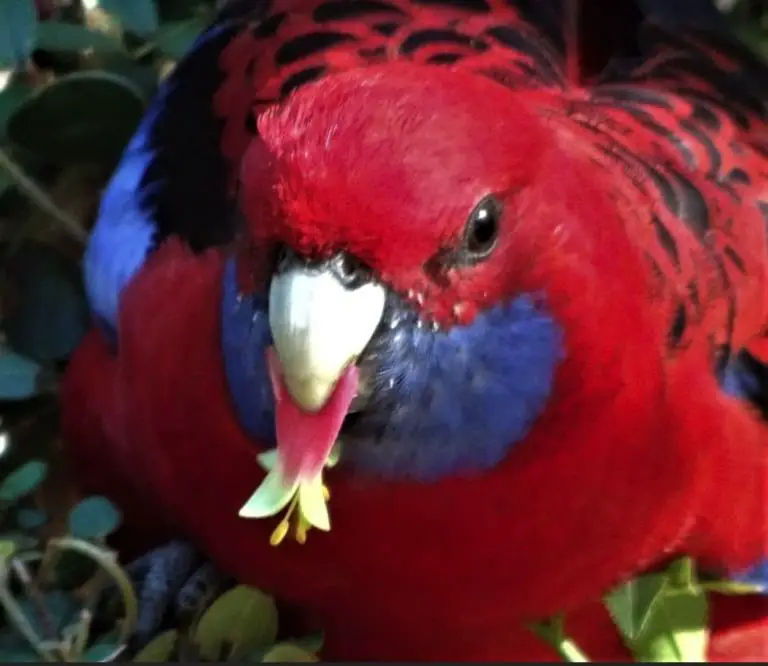
Crimson Rosellas are herbivores with their natural diet composed of seeds, fruits, nuts, nectar, berries, and other green food. Common plants that these birds love to eat are members of the Asteraceae, Myrtaceae, and Rosaceae.
The crimson rosella is not good as seed or pollen spreaders because these will crush the seeds before they eat them. Some rosellas live in areas where humans are located that eat grains and seeds from farms and gardens. This behavior makes them pests to farmers and gardeners.
Aside from plants, crimson rosellas may also eat insects and insect larvae. These will eat termites, caterpillars, weevils, beetles, moths, etc.
In captivity, the crimson rosella may eat high-quality, commercially-prepared seed mixes with sunflower, oats, safflower, millets, and hemp seeds. You may also feed your pet some fresh fruits, dried berries, vegetables, pine nuts, and jams.
Captive rosellas will also require mineral supplements during the breeding season. The most important nutrient is calcium, which is needed for bone and egg health. Also, parents need soft food as they raise their chicks.
You may also feed rosellas hemp seeds. These seeds have complete amino-acids, omega 3 and 6 fatty acids and micronutrients to help your pet grow healthy and strong. Hemp seeds also contain high amounts of protein, which is important for good health.
Captive Environment and Housing
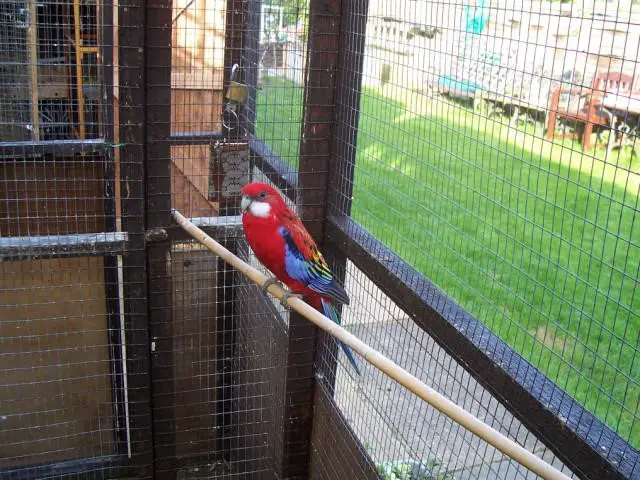
Crimson rosellas need a large space to remain in. Also, you need a very large cage if you decide to keep more rosellas for the company. Pick a spacious cage made of metal with a secure door. Keep this door locked and secure at all times.
This bird species need sturdy branches where it can sit and perch. Choose natural plants as places where they can stay or sleep. Add cage furniture for your pet to play in. Use ropes, natural perching blocks, birdhouses made of wood, a medium-sized bowl for bathing, mirrors, swings, and many more.
Place a water basin and a container for food. The container should have a wide mouth so that the bird can easily eat from it. Consider using two or more food containers if you have several birds. Also, you can place the cage on top of a sturdy surface like a table, or you can use a cage with a stand. But no matter what, the area must not be under direct sunlight and should be free from moisture.
The cage should have proper bedding to absorb urine and smells. Coconut husks or bark or wood shavings are good bedding materials. You may also use old newspapers, paper towels, or brown paper as bedding.
When cleaning the cage, remove the bird from the cage first and let it stay in a secure area or a separate cage. Hose it down to remove stuck dirt and grime. Remove food and water containers; clean these separately with a cleaning solution.
Use a natural cleaning product with disinfectant properties to remove tough dirt and smell. You may use natural plants inside the cage, and these must be cared for separately. Regularly remove felled or dead stems and leaves. Water these days and take these out from the cage to have some sun once in a while.
Health and Common Issues
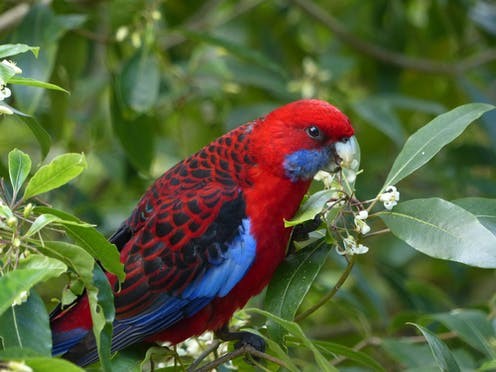
The crimson rosella is a healthy and hardy breed but may suffer from some of the following health issues.
Avian polyomavirus in birds
Avian polyomavirus is an infectious disease that affects mammals and birds. This is a deadly disease that may affect young birds. This may also be passed on to other birds through droppings and touching infected birds.
Symptoms of avian polyomavirus are the swollen abdomen, poor appetite, vomiting, diarrhea, and dehydration. If the disease remains untreated, your pet can lose weight and may even die of complications. To prevent this, have your pet vaccinated against avian polyomavirus. This disease may be passed on to humans, so you must have your pet checked right away.
Bird fever or psittacosis in birds
Bird fever is an infectious disease that is common in most species of birds. This is spread through contact with the droppings of infected birds. Some symptoms of bird fever are restlessness, watery and green droppings, discharge from the eyes and nose, lack of appetite, and lack of energy.
Bird fever must be treated ASAP because it is contagious to humans. Also, pet owners should wear proper protective equipment when feeding their pets or cleaning their cages.
Malnutrition
Birds with an imbalanced diet or have diets with insufficient nutrients may suffer from malnutrition. Any of the illnesses may also contribute to malnutrition. Symptoms of malnutrition are feather stress bars and dark feather colors.
You can avoid malnutrition by making sure that your bird is getting enough sunlight, especially when their cages are placed indoors. If you cannot move the cage, use artificial birdcage lighting.
Be very careful in changing the bird’s diet. Usually, captive birds will refuse to eat the new food and may starve themselves. When this happens, take your pet to an avian vet.
Pacheco’s disease in birds
Pacheco’s disease is a fatal viral disease due to a type of herpes virus. The infected bird may spread this disease through contact with infected droppings and nasal discharge. Sometimes, the herpes virus may be dormant in a bird and activated when it is in stress. To avoid stressing your pet.
Some stressful situations are moving, the death of a partner, and breeding. Symptoms include tremors, sinusitis, poor energy, and anorexia, green-colored droppings, and in extreme cases, death. You can prevent the spread of Pacheco’s disease by placing suspected birds on quarantine. Although this disease can be fatal to birds, it cannot be transferred to humans.
Giardia in birds
Giardia is a parasitic infection that may be passed from one infected bird to another through cysts, which are present in large numbers in the bird’s droppings. The most common cause of giardia is unclean water supply.
Symptoms may include diarrhea, weight loss, dry and itchy skin, depression, and constipation. Take your bird to the vet as soon as you see these symptoms. Giardia may be passed to humans if their water supply is the same as the contaminated water supply of birds.
Aside from these common conditions, you must check your crimson rosella for any of the following symptoms like a strange appearance or stance, plucking of feathers, trembling, poor balance, walking in circles, hanging their beak, changes in behavior or attitude and other very unique changes. Any change in the bird’s droppings, breathing, eating, feathers, legs, and feet must be consulted to a vet at once.
Preventive Care
A crimson rosella must undergo a complete physical examination every 6 to 12 months. Visit an avian veterinarian and not just an ordinary vet for the best care. If you have any concern about the health of your bird, especially its diet, don’t hesitate to talk to your vet.
Your pet must go through annual fecal examination for yeast, parasites, and bacteria infestation. Your vet must recommend vaccination for polyomavirus and routine blood testing to make sure that it is healthy.
Captive birds like the crimson rosella must have some nail and wing trimming at least twice a year. Only an avian vet can help get these done properly and carefully.
And to prevent illness, clean your bird’s cage regularly. Remove droppings and wash the cage with a safe cleaning product. Clean the feeding and drinking dishes and all its toys and cage furniture. Doing these will prevent the spread of illnesses and many health conditions.
New studies on the health of the crimson rosella
New research has shown that hybrid crimson rosellas can fight diseases than pure-breeds. An example is a heterosis where a crossbreed is more resilient than two purebreds. Researchers from the Centre for Integrative Ecology at Deakin University in Geelong, Victoria, studied the patterns of beak and feather infections in the species across the areas in southern Australia.
The study included hybrid birds in the northeastern part of Victoria and the southern parts of New South Wales. The research revealed that when the two subspecies mated, the offspring were able to cope better with a deadly virus or infection.
Availability – Where to Get One?
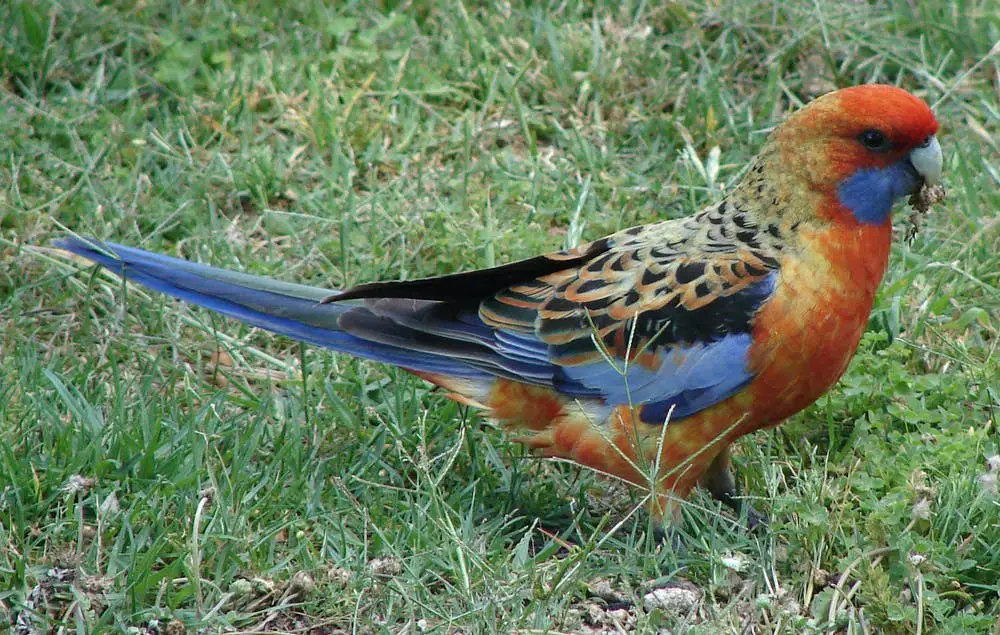
Crimson rosellas are available for sale from a breeder, or an avian pet store. You can purchase these from an online pet shop, as well. The price for a crimson rosella online is from $1000 to $1500 depending on the gender, age, and overall appearance of the bird. This is one of the most expensive species because of its lovely colors, so expect to pay a lot of money for shipment and delivery fees.
Instead of buying crimson rosellas and other exotic birds from a breeder, you can also check birds available for adoption from bird adoption or rescue organizations. These institutions are looking for new and loving families and homes for abandoned or rescued birds.
How to Care for a Crimson Rosella
Crimson rosellas have similar needs as with other parrots but also have unique requirements. Aside from providing proper basic care and medical attention, you must also be willing to commit to daily cage maintenance, feeding, and interaction. Never overlook caring for your pet because doing so will help maintain your pet’s proper mental and physical condition.
Choose an appropriately-sized cage that’s comfortable and safe. The cage should be big enough to allow your bird to spread his wings without touching the cage bars. When housing, two or more birds use a large cage or a custom-made enclosure. Add natural trees or plants to serve as perches and some safe bird toys.
Also, handle your pet regularly. This will create a close bond between you and your pet. Learn how to hold it with care and gain its trust before you start perching it on your arm and shoulders. Despite its size, this bird also has sharp claws. Use a glove to protect your hands. And since this bird is not so fond of petting and holding, give it time to adjust to avoid stress.
When it comes to feeding, give it appropriate bird food. You can use commercially-prepared food which is available in most pet shops and suppliers. For fruits and vegetables, choose organic produce only. Have a fixed feeding schedule, and don’t feed too much to avoid being overweight and other health illnesses. Always maintain a bowl with clean water inside the cage and replace water twice a day.
Place cuttlebone or any cage furniture that will allow your pet to sharpen its beak. A cuttlebone also contains calcium, and thus, your bird can ingest this mineral as it sharpens its beak. You may ask a vet to cut your pet’s nails and its tail feathers if necessary.
FAQs
What do crimson rosellas eat?
Crimson rosellas will eat plants, especially seeds, nuts, berries, fruits, and different tree parts. These birds will also eat insects and insect larvae. But in captivity, crimson rosellas will eat commercially-prepared food/pellets, fruits and vegetables, and insect larvae and mealworms.
Will crimson rosellas eat commercially-prepared bird food?
Yes, crimson rosellas will eat commercially-prepared food like pellets and seeds. Usually, commercially-prepared food is a mixture of seeds like sunflower and hemp seeds; birds love this food, but be careful not to overfeed your pet.
Are crimson rosellas endangered birds?
No, the crimson rosella is classified as a species of least concern, which means these are in abundance in their natural habitat.
How do crimson rosellas drink water?
Leave a large bowl inside the cage. This will serve as your pet’s drinking dish. You may even spot two or more crimson rosellas drinking from this dish.
How long can a crimson rosella live without food?
A crimson rosella can go one to two days without food, but do not do this since your pet can become very stressed.
Can you feed a crimson rosella on your hand?
You can practice feeding a crimson rosella on your hand by using treats or bird food. Place the food on your hand and let the bird fly in your direction. Do this repeatedly until your pet understands that it can get food when he returns to your hand.
Can you feed crimson rosellas fruits from a regular supermarket?
Yes, it can eat store-bought produce, but you must make sure that the food is organic and should not contain toxins or other dangerous chemicals that can be toxic to your pet.
What happens when your pet crimson rosella refuse to eat?
Sometimes a crimson rosella may refuse to eat, and usually, the cause could be stress or a change in food. If your pet doesn’t eat, just let it be. Do not force the new food; just wait for your pet to adjust to the new food.
Do a crimson rosellas have a special diet?
No, the crimson rosella does not have a special diet. You can feed it plants such as fruits, veggies, nuts, seeds, and herbs, and it also eats insects and larvae as well.
Can you teach a crimson rosella to speak?
You can teach it to whistle and follow sounds and tunes, but it cannot speak or mimic human voice and words. These birds are very noisy animals and will even forage noisily in groups on trees and the ground.
How do you teach a crimson rosella to whistle?
Birds like the crimson rosella learn by constant interaction. It will learn how to whistle by making the noise near its cage. Let it listen to one tune first and wait till it’s able to whistle back before you teach it other tunes or songs.
Is a crimson rosella a noisy pet?
Yes, a crimson rosella is quite noisy despite not being able to talk to human speech. It can shriek and make shrill sounds throughout the day and mostly when it feels threatened or afraid.
Can a crimson rosella tell if there is a threat or a stranger?
Like a dog, you can trust that a crimson rosella will emit a loud noise when it feels threatened or when there is a stranger. But you can’t count on it to sound every time.
Is a crimson rosella nocturnal?
No, the crimson rosella is not a nocturnal animal. It will hunt, forage, eat and socialize with other members of its flock in the day and will rest or sleep at night.
Will a crimson rosella hibernate?
No, this bird does not hibernate. When the temperature drops, this bird may remain in its nest or burrow to wait it out, but it will not hibernate.
How do crimson rosellas make their nest?
The mother bird is the one who selects the site where the nest will be usually a tall, hollow tree. Once the female has decided on the nest, she and her partner will prep the nest by carving out the walls with their beaks. The shavings are also used as the floor of the nest where the babies are laid. They don’t use any building material from outside the nest.
How long will a crimson rosella egg hatch?
An egg may hatch in three weeks or more. The female is the only one who sits on the nest to warm them. The eggs will hatch according to the age of the egg.
Can you take a crimson rosella egg from the nest and hatch it?
Yes, you can do this, but as much as possible, let the mother bird take care of her babies. But if you happen to find an abandoned nest, you can take the egg and incubate this at home using thick blankets and a lamp.
Are crimson rosella diseases harmful to humans?
Some bird diseases like the flu may be passed on to humans if you touch the feces and the nasal discharge of an infected bird. So if you suspect your pet is sick, take it to the vet at once.
Are there vaccinations for pet birds?
Yes, pet birds need to be vaccinated to prevent different diseases. Your vet will help your pet get complete vaccinations from the first time you get your bird.
What are the signs of a sick crimson rosella?
Rosellas are active, energetic, noisy, and mischievous with a lovely feather, firm body, and a good appetite. The opposites of these healthy signs could mean that your bird is sick or needs medical attention right away.
What to do with a sick crimson rosella?
Crimson rosellas that show signs of sickness must be taken to the vet right away. Meanwhile, vomiting, constipation, diarrhea, and loss of consciousness are dangerous signs, and your pet should be taken to the vet as soon as possible.
Can you place the cage of crimson rosellas indoors?
Yes, you can place the cage indoors as long as it is near a natural light source like an open window. Use a lamp to shine on your pets if a window is not present.
Can a crimson rosella stay with other species inside a cage?
Yes, the crimson rosella can remain with other parrot or bird species inside a cage. As long as the cage is large enough, you can take care of several birds at a time. Take note that the birds must have adequate space so there won’t compete with space.
How do you bathe your pet crimson rosella?
You cannot bath your pet. However, you can place a large basin in the middle of the cage where the birds can bathe on their own.
When is the best time to feed a pet crimson rosella?
The best time to eat is when it’s very active, and this is according to your pet. If it is active in the mornings, then let his time be its feeding time. You may also feed it in the afternoons or in the evenings.

